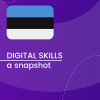Digital Competence Initiative in Estonia
The Estonian national curriculum pays emphasis to the development of digital competences. It is one of the 8 key competences that the schools in Estonia focus on.
To make it easier for teachers, Estonia has created a simple and clear digital competence model for students. In this way, every Estonian teacher no longer has to invent their own wheel but can focus on supporting the learner.
The Estonian framework explained
Defined competences serve as targets for both teachers and students. As such, student and teachers digital competence frameworks offer integrated and common reference points to analyse whether learning takes place. These describe the competences needed to solve problems faced during learning processes (de facto in working life as well) using digital technologies. It is also adapted to the Estonian education context.
The students’ digital competence framework is adapted to DigComp 2.1, the EU-wide framework of the European Commission. It has 5 dimensions: 1) information and data literacy (ex: articulating needs, judging the relevance of sources, organising digital data; 2) communication and collaboration, 3) digital content creation (ex: editing, understanding copyright, knowing your way around computer systems; 4) safety and 5) problem-solving. The digital competence framework for teachers was based on the DigCompEdu , 2017) and it has six dimensions: 1) Professional development and involvement, 2) Digital learning material, 3) Teaching and learning, 4) Evaluation, 5) Student empowerment, 6) Development of students' digital competence.
How it works in practice
The digital competence frameworks are complemented with diverse tools that are intended to support their implementation. These include:
- Assessment criteria. There is a publicly accessible set of student and teacher assessment criteria for each key stage of education, linked to the five dimensions of the digital competence framework. In turn, they can use the new data to plan strategies for enhancing learning further. Students can also use the criteria to set their own learning targets while teachers can assess their knowledge and improve their digital skills. There is an additional adapted version of the assessment criteria for students with special needs.
- Self-assessment survey. An online digital competence self-assessment questionnaire is available to schools, teachers and students for lower- and upper-secondary students in different formats.
- Digital technology glossary. There is a digital glossary associated with the student competence frameworks, as well as with digital assessment criteria and digital learning in general. These provide teachers and students, with the common language needed to discuss digital teaching and learning.
- Digital learning scenarios. Digital learning scenarios which describe best practices in integrating learning and the development of digital competences in various school subjects are being collected. These learning scenarios are published with open access.
The Digital Competence Task Force
The Digital competence Initiative is led by the Education and Youth Board of Estonia, which also has a special Digital Competence Task Force. They monitor developments and produce reports, pilot and test new tools, keep materials (including frameworks) up to date, present the results, etc.
The task force reports on the results and developments twice a year, to the Digital Competence Advisory Board, which consists of 10 representatives from key organisations in Estonia (Estonian Association of Educational Technologists, Estonian Association for Advancement of Vocational Education, Estonian Teachers’ Association, University of Tartu, Estonian Informatics Teachers’ Association, Estonian Association of Kindergarten Teachers, Tallinn University, Estonian Qualifications Authority, Estonian Association of Heads of Schools and the Estonian Ministry of Education and Research).




